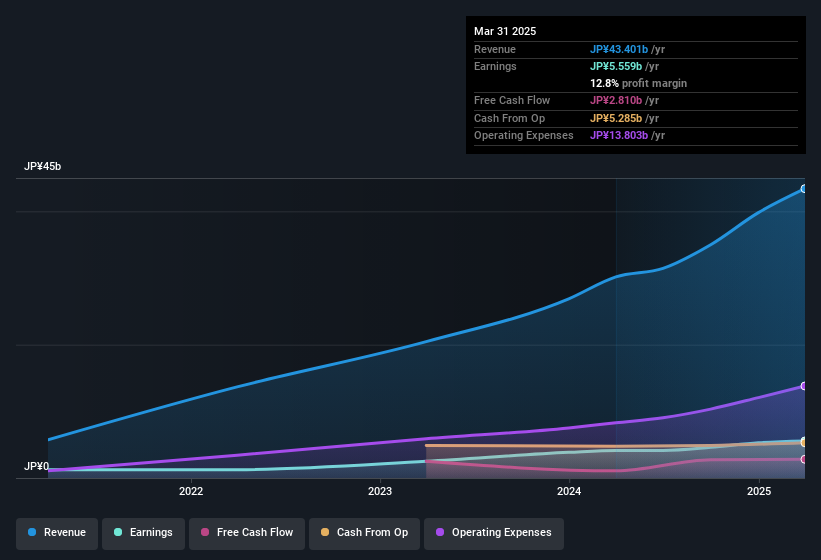Investors appear disappointed with COVER Corporation's (TSE:5253) recent earnings, despite the decent statutory profit number. We think that they may be worried about something else, so we did some analysis and found that investors have noticed some soft numbers underlying the profit.

A Closer Look At COVER's Earnings
One key financial ratio used to measure how well a company converts its profit to free cash flow (FCF) is the accrual ratio. In plain english, this ratio subtracts FCF from net profit, and divides that number by the company's average operating assets over that period. This ratio tells us how much of a company's profit is not backed by free cashflow.
As a result, a negative accrual ratio is a positive for the company, and a positive accrual ratio is a negative. That is not intended to imply we should worry about a positive accrual ratio, but it's worth noting where the accrual ratio is rather high. Notably, there is some academic evidence that suggests that a high accrual ratio is a bad sign for near-term profits, generally speaking.
Over the twelve months to March 2025, COVER recorded an accrual ratio of 0.69. That means it didn't generate anywhere near enough free cash flow to match its profit. As a general rule, that bodes poorly for future profitability. To wit, it produced free cash flow of JP¥2.8b during the period, falling well short of its reported profit of JP¥5.56b. We note, however, that COVER grew its free cash flow over the last year. Unfortunately for shareholders, the company has also been issuing new shares, diluting their share of future earnings.
That might leave you wondering what analysts are forecasting in terms of future profitability. Luckily, you can click here to see an interactive graph depicting future profitability, based on their estimates.
One essential aspect of assessing earnings quality is to look at how much a company is diluting shareholders. COVER expanded the number of shares on issue by 5.6% over the last year. Therefore, each share now receives a smaller portion of profit. To talk about net income, without noticing earnings per share, is to be distracted by the big numbers while ignoring the smaller numbers that talk to per share value. You can see a chart of COVER's EPS by clicking here.
A Look At The Impact Of COVER's Dilution On Its Earnings Per Share (EPS)
As you can see above, COVER has been growing its net income over the last few years, with an annualized gain of 347% over three years. In comparison, earnings per share only gained 325% over the same period. And the 34% profit boost in the last year certainly seems impressive at first glance. On the other hand, earnings per share are only up 31% in that time. And so, you can see quite clearly that dilution is influencing shareholder earnings.
Changes in the share price do tend to reflect changes in earnings per share, in the long run. So COVER shareholders will want to see that EPS figure continue to increase. However, if its profit increases while its earnings per share stay flat (or even fall) then shareholders might not see much benefit. For that reason, you could say that EPS is more important that net income in the long run, assuming the goal is to assess whether a company's share price might grow.
Our Take On COVER's Profit Performance
As it turns out, COVER couldn't match its profit with cashflow and its dilution means that earnings per share growth is lagging net income growth. Considering all this we'd argue COVER's profits probably give an overly generous impression of its sustainable level of profitability. If you'd like to know more about COVER as a business, it's important to be aware of any risks it's facing. You'd be interested to know, that we found 2 warning signs for COVER and you'll want to know about these.
Our examination of COVER has focussed on certain factors that can make its earnings look better than they are. And, on that basis, we are somewhat skeptical. But there are plenty of other ways to inform your opinion of a company. For example, many people consider a high return on equity as an indication of favorable business economics, while others like to 'follow the money' and search out stocks that insiders are buying. While it might take a little research on your behalf, you may find this free collection of companies boasting high return on equity, or this list of stocks with significant insider holdings to be useful.
New: AI Stock Screener & Alerts
Our new AI Stock Screener scans the market every day to uncover opportunities.
• Dividend Powerhouses (3%+ Yield)
• Undervalued Small Caps with Insider Buying
• High growth Tech and AI Companies
Or build your own from over 50 metrics.
Have feedback on this article? Concerned about the content? Get in touch with us directly. Alternatively, email editorial-team (at) simplywallst.com.
This article by Simply Wall St is general in nature. We provide commentary based on historical data and analyst forecasts only using an unbiased methodology and our articles are not intended to be financial advice. It does not constitute a recommendation to buy or sell any stock, and does not take account of your objectives, or your financial situation. We aim to bring you long-term focused analysis driven by fundamental data. Note that our analysis may not factor in the latest price-sensitive company announcements or qualitative material. Simply Wall St has no position in any stocks mentioned.
About TSE:5253
COVER
Engages in the virtual platform, VTuber production, and media mix businesses.
Flawless balance sheet and undervalued.
Similar Companies
Market Insights
Community Narratives





